
Aesthetic Programming: A Handbook of Software Studies (Liquid/Living Books) PDF
Preview Aesthetic Programming: A Handbook of Software Studies (Liquid/Living Books)
Aesthetic Programming A Handbook of Software Studies Winnie Soon and Geoff Cox Web https://www.aesthetic-programming.net Repository https://gitlab.com/aesthetic-programming/book FrontColophon AESTHETIC PROGRAMMING A Handbook of Software Studies Winnie Soon and Geoff Cox Published by Open Humanities Press 2020 https://openhumanitiespress.org/ ISBN (print) 978-1-78542-094-8 ISBN (PDF) 978-1-78542-093-1 © CC-BY-SA 2020, the authors Table of Contents Table of Contents Table of Contents Preface Design notes 1. Getting started 2. Variable geometry 3. Infinite loops 4. Data capture 5. Auto generator 6. Object abstraction 7. Vocable code 8. Que(e)ry data 9. Algorithmic procedures 10. Machine unlearning Afterword: Recurrent imaginaries Bibliography List of Projects Acknowledgements 3 Aesthetic Programming 1 FrontColophon 2 Table of Contents 3 Preface 11 – What kind of book is this? 13 – Why aesthetic programming? 14 – And software studies? 16 – Open publishing 17 – Flow of contents 18 – The book object 21 – Notes 22 Design notes 25 – Book layout 25 – Fonts 25 1. Getting started 27 – setup() 29 – start() 30 – Working environment 31 – p5.js 32 – Code editor 33 – My first program 35 – Exercise in class 36 – Reading the web console “Hello World” 37 – Reading the reference guide 39 – Git 42 – While() 44 – MiniX: RunMe and ReadMe 46 – Required reading 47 – Further reading 47 – Notes 48 2. Variable geometry 51 – setup() 53 – start() 55 – Source code 56 – Coordinates 58 – Exercise in class 58 – Variables 60 – Why use variables? 62 Table of Contents – Other functions 63 – Conditional structures 63 – Relational operators 64 – Basic arithmetic operators 65 – Discussion in class 66 – While() 66 – MiniX: Geometric emoji 68 – Required reading 69 – Further reading 69 – Notes 70 3. Infinite loops 71 – setup() 73 – start() 74 – Exercise in class (Decode) 75 – Source code 77 – Function 78 – Exercise in class 79 – Transform 79 – push() and pop() 81 – Exercises in class 83 – Asterisk Painting 83 – Source code 84 – Exercise in class 86 – Arrays 87 – Conditional statements 89 – Loops 89 – While() 92 – MiniX: Designing a throbber 93 – Required reading 94 – Further reading 95 – Notes 96 4. Data capture 97 – setup() 99 – start() 100 – Exercise in class (Decode) 101 – Source code 101 5 – DOM elements: creating and styling a button 103 – Mouse capture 104 – Keyboard capture 105 – Audio capture 106 – Video/Face capture 107 – Exercise in class 110 – The concept of capture 111 – Web analytics and heatmap 111 – Form elements 112 – Metrics of likes 113 – Voice and audio data 114 – Health tracker 115 – While() 115 – MiniX: Capture All 117 – Required reading 118 – Further reading 118 – Notes 119 5. Auto-generator 121 – setup() 123 – start() 126 – Exercise in class (10 PRINT) 127 – Langton’s Ant 128 – Source code (Langton’s Ant) 131 – Reading Langton’s Ant 133 – Two-dimensional arrays & nested for-loops 134 – Exercise in class 135 – While() 136 – MiniX: A generative program 139 – Required reading 140 – Further reading 140 – Notes 141 6. Object abstraction 143 – setup() 145 – start() 146 – Exercise in class (Decode) 148 – Source code 149 Table of Contents – Class 153 – Objects 154 – Class-Object creation 158 – Exercise in class 158 – Further notes 159 – While() 160 – MiniX: Games with objects 162 – Required reading 163 – Further reading 163 – Notes 164 7. Vocable code 165 – setup() 167 – start() 168 – Exercise in class (Decode) 169 – Textuality 171 – Type 172 – Conditional structure 173 – JSON 175 – Source code 178 – Exercise in class 180 – While() 181 – MiniX: E-lit 184 – Required reading 185 – Further reading 185 – Notes 186 8. Que(e)ry data 187 – setup() 189 – start() 190 – Exercise in class 190 – Image processing: fetching, loading and display 191 – Source code 193 – Exercise: accessing web APIs (step by step) 194 – APIs 196 – Que(e)rying data 197 – Exercise in class 200 – LoadPixels() 201 7 – Different types of bugs 204 – While() 205 – MiniX: Working with APIs (in a group) 207 – Required reading 208 – Further reading 208 – Notes 209 9. Algorithmic procedures 211 – setup() 213 – start() 214 – Discussion in class 214 – Flowcharts 215 – Exercise in class 217 – Exercise 1 217 – Exercise 2 217 – Flowcharts as an artistic medium 218 – While() 220 – MiniX: Flowcharts 222 – Required reading 223 – Further reading 223 – Notes 224 10. Machine unlearning 227 – setup() 229 – start() 231 – Between input and output 231 – Exercise in class 232 – Learning algorithms 233 – ml5.js library 237 – Source code 238 – Reading Auto Chapter Generator 241 – Exercise in class 243 – While() 243 – MiniX: final project 246 – Required reading 248 – Further reading 248 – Notes 249
